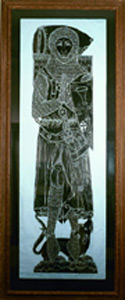Brass Rubbing: Sir Roger de Trumpington
1997.05.0002
Detailed Images
Basic Information
| Artifact Identification | Brass Rubbing: Sir Roger de Trumpington (1997.05.0002) |
|---|---|
| Classification/ Nomenclature |
|
| Artist/Maker | Unknown |
| Geographic Location | |
| Period | N/A |
| Date | 1289 |
| Culture | N/A |
| Location | Not on Exhibit |
Physical Analysis
| Dimension 1 (Height) | 246.0 cm |
|---|---|
| Dimension 2 (Width) | 100.3 cm |
| Dimension 3 (Depth) | 4.0 cm |
| Weight | N/A |
| Measuring Remarks | N/A |
| Materials | Plant--Wood, Paper, Glass, Wax |
| Manufacturing Processes | Rubbing |
Research Remarks
| Description | N/A |
|---|---|
| Published Description | Under Review |
| Bibliography | Horowitz, Mark R. The Monumental Brasses of England: The Horrowitz Collection. Morton Grove, IL: Portcullis Productions, 1980 (1979). p. 7-8. |
Artifact History
| Credit Line/Dedication | The Horowitz Collection |
|---|---|
| Reproduction | Yes |
Contact
All information about our collection is constantly reviewed and updated. Please contact Dery Martínez-Bonilla, Registrar, if there is any information you are looking for that isn't currently online.
